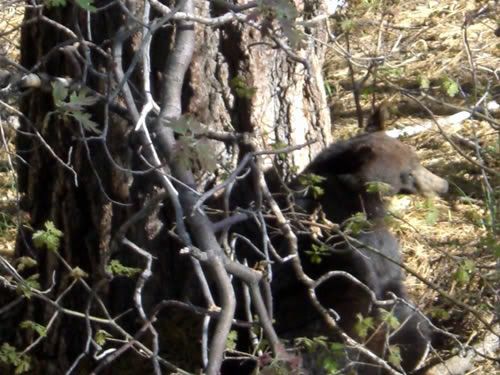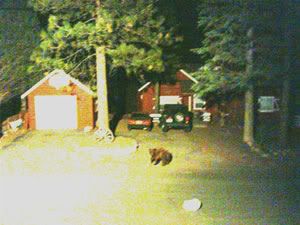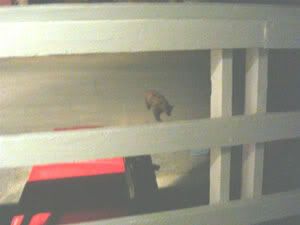
Above: Photo taken of a bear in a tree in the town of Fawnskin, California. See more bear pictures here.
Locals have nicknamed one of the bears that has moved into town to dine on the garbage left out for pick up on Wednesday night, “Yogi.” One email said he was on his way to a “picca nicca”–aka trash digging.
 But the problem is that some people might really think the local bears are Yogi Bear or Boo Boo–wrong–they are wild animals.
But the problem is that some people might really think the local bears are Yogi Bear or Boo Boo–wrong–they are wild animals.
Since the wildfires last summer, the sightings of wildlife has increased significantly. Not only did one of my neighbors see a cougar jump off her roof but another a few miles down the road glimpsed “the beast of Big Bear” ambling down her road during the late morning hours.
Up the road, the bear garbage gourmet has learned how to pop off the locking lids of “bear proof” trash cans.
Although people might like the wildllife viewing, for the welfare of the furry freeloader it is best to always follow the following tips if you live in or near bear country:
- Rinse food cans and wrappers before disposal. Keep garbage cans clean and deodorize them periodically.
- Don’t leave trash, groceries or animal feed in your car.
- Place trash cans at the curb on collection day rather than the night before. If trash must be kept outside, invest in a bear-proof garbage cage or keep inside your garage or shed.
- Harvest fruit off trees as soon as it is ripe, and promptly collect fruit that falls.
- Only provide bird feeders outside during the coldest months of the year—generally November through March—and always hang feeders so they are inaccessible to bears.
- Plant your garden in the open, away from cover.
- Don’t keep an open compost pile, especially one in which household leftovers are dumped. Burying compost is also not advisable, as bears will easily dig it up if motivated by enticing odors.
- Keep barbecue grills that are on decks or close to the house clean. If possible, move the grill well away from the house when not in use.
- Don’t feed pets outdoors and remove their water when you bring them in.
- Block access to potential sleeping sites such as crawl spaces under decks and buildings.
- Don’t leave any scented products outside. Non-food items such as suntan lotion, insect repellent, soap, and candles can serve as attractants
 For additional tips for living with bears visit the Wind River Bear Dog website, or download and print the Living with California Black Bears brochure (PDF).
For additional tips for living with bears visit the Wind River Bear Dog website, or download and print the Living with California Black Bears brochure (PDF).
You can also read what the Arizona Department of Fish & Game black bear page has to say. The Lake Tahoe Council for Wild Bears helps those who have encountered bears in that area of California and you can read about the black bear challenges Ann Bryant and her volunteers face.
If more people followed the above common sense tips it would help reduce the chance of having these animals being called in as nuisance critters…and might even save their lives.


Urban Wildlife: Who are you gonna call?
Above: American Black Bear in Fawnskin, California
There seems to be some confusion as to who has jurisdiction over animals in an urban setting near wildlife habitat. The recent wildfires have shrunk local habitat and so animals are turning up in record numbers in the local area–and someone left a message about the bear over in the TwentyNine Palms area.
As this article states, the heat is unbearable and up here we are seeing animals seeking water in areas they would most likely avoid and during abnormal times.
In most cases you need to start with a phone call to Animal Control. Sometimes they get the moniker of Animal Services. They have the local numbers they need to call for assistance if they cannot handle the situation.
In our area we have the Fish & Game Warden for crimes against wildlife or violations of law concerning wildlife.
In addition, we have Forestry biologists who monitor the animals and a Fish & Game Biologist that handles nuisance animals.
It can get a little confusing especially since we also have the Bureau of Land Management–who handles animals in the areas under their jurisdiction.
If the animal is an escaped critter from a captive facility–well then add the USDA (United States Department of Agriculture) to the mix.
Are you shaking your head yet? Try figuring it out if you live in an area with ALL of these agencies–like I do.
Please remember that rescue groups, humane societies, and small wildlife rehabilitation centers do not have jurisdiction (in most cases) and most will not have the skill set or equipment for dealing with large predators.
If you call the police or sheriff, in most case they will shoot the animal in question if they feel it is a public safety threat.
For the bear’s sake, keep your distance and avoid any interactions. While you are at it, pull up any outdoor food and water sources for birds, other wildlife, and those for your pets.
Do you have a comment about this topic? Leave it below.